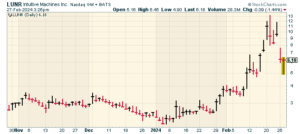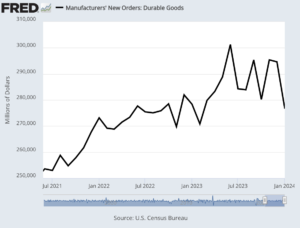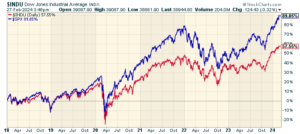CWS Market Review – February 27, 2024
(This is the free version of CWS Market Review. If you like what you see, then please sign up for the premium newsletter for $20 per month or $200 for the whole year. If you sign up today, you can see our two reports, “Your Handy Guide to Stock Orders” and “How Not to Get Screwed on Your Mortgage.”)
LUNR Falls Back to Earth
I feel terrible for the company Intuitive Machines (LUNR). This was the team that flew its craft, named Odysseus, to the moon and landed it on the lunar surface. This was the first time Americans had done so in over 50 years.
There was, however, one small problem. Odysseus landed on its side. That wasn’t supposed to happen. In my opinion, who cares?! They effectively landed a Roomba on another planet. Dear lord, that’s amazing!
So what if they got some minor details wrong? They got the first 99.999999% of the mission right. Odysseus is the first privately-built craft in history to make a soft landing on the moon.
Mind you, Odysseus is still working fine. It’s even been able to send back incredible photos. It’s just lying on its side. I mean, Odysseus is chillin’. Who cares?
Well, the markets, apparently. On Monday, shares of Intuitive Machines plunged 35%. At one point today, LUNR was down another 20%. The market gods can be a cruel bunch.
This is, however, an important lesson for investors. The stock market is not swayed by emotion. No matter how much you may wish for something to happen, the market simply doesn’t care. After all, shares of LUNR jumped 530% between the stock’s January low and its February high. The company had initially reported that the landing went well. Only when the evidence became clear did they say there was a problem.
I’m on LUNR’s side. Not enough to be an investor, but certainly enough to be a fan. This is a good reminder that a near-term share-price move isn’t the end of the world. Or even the moon.
Durable Goods Plunge the Most in Four Years
This morning, the Commerce Department released the durable goods report for January, and it was pretty bleak.
Last month, orders for durable goods fell by 6.1%. That was even below Wall Street’s already pessimistic forecast for a drop of 4.5%. This was the biggest drop in nearly four years, and that report came during the initial stages of Covid.
When we say durable goods, we mean things that are intended to last more than three years. This data can be a good omen for future economic growth. People tend to buy durable goods when they’re optimistic. That’s why today’s report is so concerning.
The data for December was revised lower to a drop of 0.3%. The initial report had been for it to remain unchanged. These reports may suggest that the economy is downshifting from robust growth towards the end of last year.
A major factor for the lousy report is a 59% drop in in civilian aircraft orders. According to MarketWatch, “Boeing reported on its website that it had received only three orders for commercial aircraft in January, sharply down from 371 in December.”
Overall transportation orders dropped 16.2% last month after slipping 0.6% in December. Orders for motor vehicles and parts fell 0.4%. Excluding transportation, durable goods orders fell 0.3% last month after dipping 0.1% in December.
There were decreases in orders of primary and fabricated metals. Machinery orders were unchanged. But orders for computers and electronic products increased 1.4%, while those for electrical equipment, appliances and components rose 0.9%.
Economists like to look at “core capital goods” which is non-defense capital goods minus aircraft orders. That’s considered to be a good proxy for business spending. For February, it edged up by 0.1%. For January, it was down by 0.6%.
There’s been a lot of talk about “seasonality effects” or the impact of weather or the news of large-scale layoffs. For example, Google is laying off 12,000 employees after reporting a profit of $20 billion for Q4. Of course, that’s what a profit-making enterprise does. We’ll need to see more data, but the economy may be slowing down right now.
Also this morning, the Conference Board said that its consumer confidence index fell to 106.7. Economists had been expecting 115. The number for January was revised lower to 110.9. This is another worrying sign.
On Monday, the Commerce Department said that sales of new homes rose in January but by less than expected. Sales of single-family homes totaled 661,000 last month (that’s an annualized figure). Wall Street had been expecting 690,000. One bright spot is that it was a 1.5% increase over December.
Meanwhile, the median sales price of new houses last month came in at $420,700, up from $413,100 in December. One problem impacting the housing market is that there’s relatively low supply. Since so many people locked in mortgages when rates were lower, they’re skittish about putting their homes on the market right now.
I don’t think the economy is in serious trouble right now, but this week’s reports do concern me. We’ll need to see more reports before we can definitely say that the economy is in trouble. The odds of no rate cut coming in June are slowly getting higher.
Tomorrow, the government will update its report on Q1 GDP growth. The initial report was quite good. On Thursday, we’ll get the PCE price data. This is the Fed’s preferred measure for inflation. Then on Friday, the ISM Manufacturing Index comes out.
Amazon Joins the Dow
Yesterday, Amazon (AMZN) joined the Dow Jones Industrial Average. This is Wall Street’s equivalent of being a “made man.”
It’s a big deal. There are only 30 stocks in the index so when one goes in, another comes out. This time, it was Walgreens Boots Alliance (WBA) that got the boot. The company recently cut its dividend and I think that prompted the index keepers to make a move.
The Dow doesn’t change its members very often. This was the first change to the Dow in nearly four years. Actually, the Dow has been getting slightly more active in recent years.
The Dow didn’t make any changes to the index from 1939 to 1956 when it replaced Loew’s Theatres with International Paper. They made four more changes in 1959 but that was it until 1976. All told, the index went 37 years with only making four changes to its roster. Since its founding in 1897, the Dow has made about 130 changes.
In 1939, the gatekeepers of the Dow removed IBM (IBM) from its index. That was a huge mistake. It was added back in 1979. Over those 40 years, IBM was a huge winner for investors. If the Dow folks had left it alone, the Dow’s level would be much higher today.
I’m not a big fan of the Dow. My preference is to follow the S&P 500, and that’s usually what I reference when I’m speaking of the market as a whole. Investors see it that way as well. Among index funds, $5.75 trillion is indexed to the S&P, but only $87 billion is indexed to the Dow.
The lack of tech stocks has hurt the Dow. In recent years, the S&P 500 (in blue) has significantly outperformed the Dow (in red).
The S&P 500 is a larger index, but the other reason is that it’s weighted by market value while the Dow is weighted by price. To calculate the Dow, you simply add up all the prices and adjust it by a multiple.
Before this week’s change, each $1 in the share price of a Dow member worked out to about 6.6 Dow points. Since Walgreens is around $20 per share, it was barely a blip in the index. It was, by far, the lowest-weighted stock in the index. Amazon is currently around $173 per share. Recall that Amazon split its stock 20-for-1 less than two years ago. (Google did a 20-for-1 a little bit after Amazon.)
There’s also the issue of Walmart splitting its stock 3-for-1. Even though nothing changes, Walmart’s weighting in the Dow will drop by two-thirds. Price weighting simply makes little sense. I understand why it was used in 1896, but not today. The Dow is an anachronism. The best index to follow is the S&P 500.
That’s all for now. I’ll have more for you in the next issue of CWS Market Review.
– Eddy
P.S. If you want more info on our ETF, you can check out the ETF’s website.
Posted by Eddy Elfenbein on February 27th, 2024 at 7:18 pm
The information in this blog post represents my own opinions and does not contain a recommendation for any particular security or investment. I or my affiliates may hold positions or other interests in securities mentioned in the Blog, please see my Disclaimer page for my full disclaimer.
-
-
Archives
- June 2025
- May 2025
- April 2025
- March 2025
- February 2025
- January 2025
- December 2024
- November 2024
- October 2024
- September 2024
- August 2024
- July 2024
- June 2024
- May 2024
- April 2024
- March 2024
- February 2024
- January 2024
- December 2023
- November 2023
- October 2023
- September 2023
- August 2023
- July 2023
- June 2023
- May 2023
- April 2023
- March 2023
- February 2023
- January 2023
- December 2022
- November 2022
- October 2022
- September 2022
- August 2022
- July 2022
- June 2022
- May 2022
- April 2022
- March 2022
- February 2022
- January 2022
- December 2021
- November 2021
- October 2021
- September 2021
- August 2021
- July 2021
- June 2021
- May 2021
- April 2021
- March 2021
- February 2021
- January 2021
- December 2020
- November 2020
- October 2020
- September 2020
- August 2020
- July 2020
- June 2020
- May 2020
- April 2020
- March 2020
- February 2020
- January 2020
- December 2019
- November 2019
- October 2019
- September 2019
- August 2019
- July 2019
- June 2019
- May 2019
- April 2019
- March 2019
- February 2019
- January 2019
- December 2018
- November 2018
- October 2018
- September 2018
- August 2018
- July 2018
- June 2018
- May 2018
- April 2018
- March 2018
- February 2018
- January 2018
- December 2017
- November 2017
- October 2017
- September 2017
- August 2017
- July 2017
- June 2017
- May 2017
- April 2017
- March 2017
- February 2017
- January 2017
- December 2016
- November 2016
- October 2016
- September 2016
- August 2016
- July 2016
- June 2016
- May 2016
- April 2016
- March 2016
- February 2016
- January 2016
- December 2015
- November 2015
- October 2015
- September 2015
- August 2015
- July 2015
- June 2015
- May 2015
- April 2015
- March 2015
- February 2015
- January 2015
- December 2014
- November 2014
- October 2014
- September 2014
- August 2014
- July 2014
- June 2014
- May 2014
- April 2014
- March 2014
- February 2014
- January 2014
- December 2013
- November 2013
- October 2013
- September 2013
- August 2013
- July 2013
- June 2013
- May 2013
- April 2013
- March 2013
- February 2013
- January 2013
- December 2012
- November 2012
- October 2012
- September 2012
- August 2012
- July 2012
- June 2012
- May 2012
- April 2012
- March 2012
- February 2012
- January 2012
- December 2011
- November 2011
- October 2011
- September 2011
- August 2011
- July 2011
- June 2011
- May 2011
- April 2011
- March 2011
- February 2011
- January 2011
- December 2010
- November 2010
- October 2010
- September 2010
- August 2010
- July 2010
- June 2010
- May 2010
- April 2010
- March 2010
- February 2010
- January 2010
- December 2009
- November 2009
- October 2009
- September 2009
- August 2009
- July 2009
- June 2009
- May 2009
- April 2009
- March 2009
- February 2009
- January 2009
- December 2008
- November 2008
- October 2008
- September 2008
- August 2008
- July 2008
- June 2008
- May 2008
- April 2008
- March 2008
- February 2008
- January 2008
- December 2007
- November 2007
- October 2007
- September 2007
- August 2007
- July 2007
- June 2007
- May 2007
- April 2007
- March 2007
- February 2007
- January 2007
- December 2006
- November 2006
- October 2006
- September 2006
- August 2006
- July 2006
- June 2006
- May 2006
- April 2006
- March 2006
- February 2006
- January 2006
- December 2005
- November 2005
- October 2005
- September 2005
- August 2005
- July 2005



 Eddy Elfenbein is a Washington, DC-based speaker, portfolio manager and editor of the blog Crossing Wall Street. His
Eddy Elfenbein is a Washington, DC-based speaker, portfolio manager and editor of the blog Crossing Wall Street. His